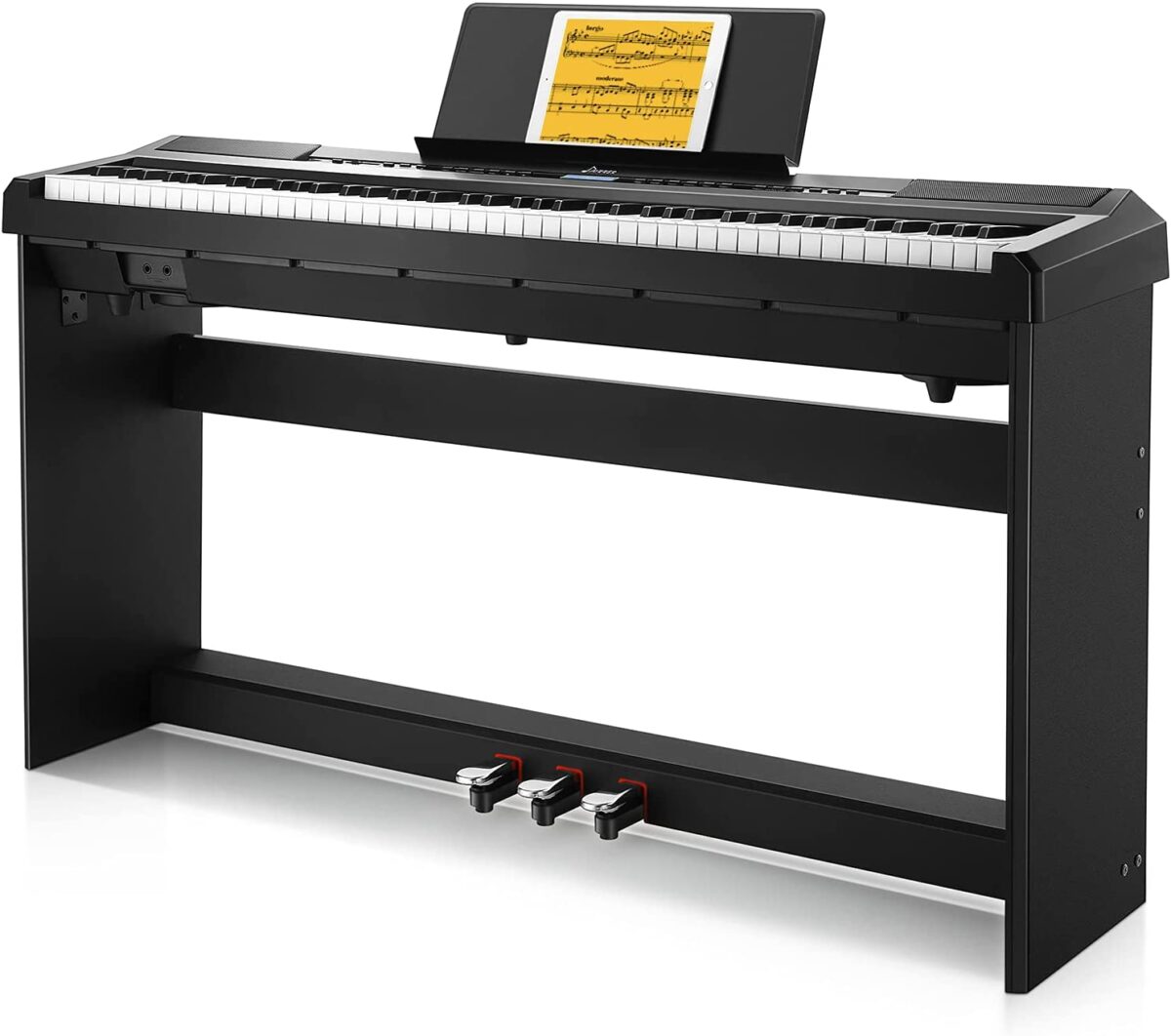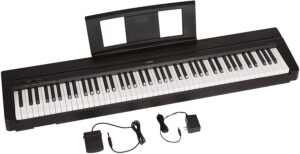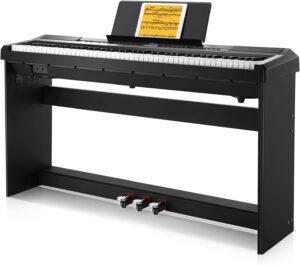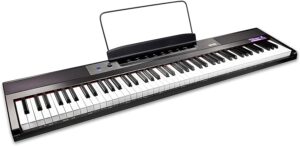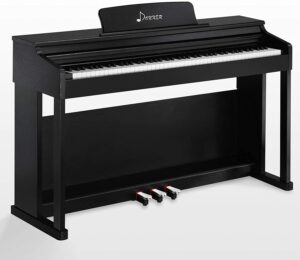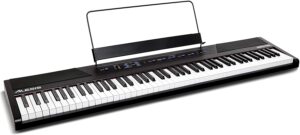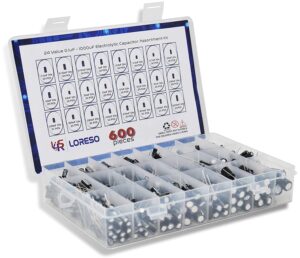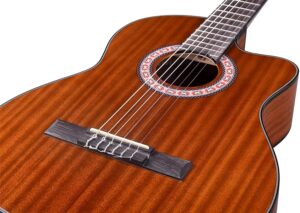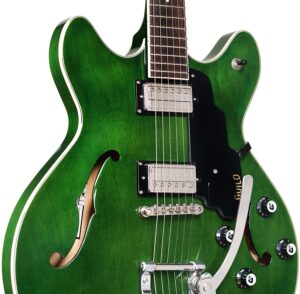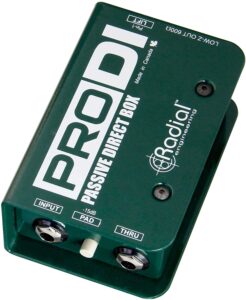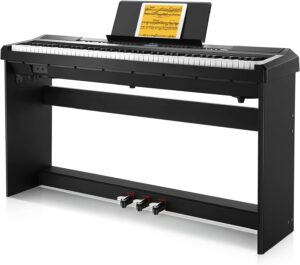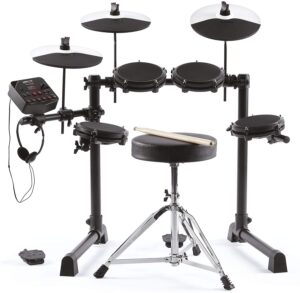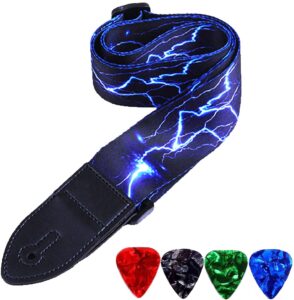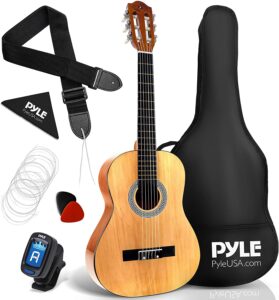| IMAGE | PRODUCT | DETAILS | ||
|---|---|---|---|---|
|
Our Top Pick
|
Our Top Pick |
YAMAHA P71 Digital Piano with 88-Keys |
|
Check Latest Price |
|
2
|
2 |
Donner DEP-20 Digital Piano for Beginners |
|
Check Latest Price |
|
3
|
3 |
RockJam 88-Key Digital Piano for Beginners |
|
Check Latest Price |
|
4
|
4 |
Donner DDP-100 88 Key Digital Piano |
|
Check Latest Price |
|
5
|
5 |
Alesis Recital Digital Piano |
|
Check Latest Price |
5 Best Digital Piano under $2000
Some brands are a class apart, and Yamaha is one of them. This is an awesome digital piano that comes with 88 fully weighted keys, which gives you the feel of a classical acoustic piano. It has ten different voices, including tones from acoustic grand pianos from the same brand. You can combine two voices using the dual-mode. The design of this piano makes it ideal for small spaces, with a weight of around 25 pounds. The set includes a power adapter and sustain pedal.
What We Liked
- Acoustic piano feel
- 88 fully-weighted keys
- 10 different voices
- Features dual mode
- Lightweight
- Depth less than 12-inch
- Includes power adapter and sustain pedal
What We Didn’t Like
- No backlit screen
This is a full-weighted 88-key piano from Donner, which is superb, easy to use, and can adapt to a wide range of playing styles. There are over 230 tone types included in the piano, and users and musicians can largely benefit from the 128-note max polyphony. The dual-tone mode is included for combining two different voices together, while the backlit LCD screen ensures that all the notes are displayed aptly on the screen. If you are a beginner looking for a budget piano, this is the one to go for.
What We Liked
- 88 fully-weighted keys
- Comes with 230 tone types
- 128-note max polyphony
- Double Keyboard
- Comes with a backlit LCD screen
What We Didn’t Like
- None
This is a beginner digital piano that comes with full-size semi-weighted 88-keys, meant to offer the acoustic feel of a real piano. It comes with 10 unique voices, including grand piano, strings, bass, and guitar, and also features a set of built-in stereo speakers, which offer 24W of sound. For play-along, there’s an included USB input. Just play your favorite songs whenever you want with this incredible digital piano.
What We Liked
- Comes with full-size semi-weighted 88-keys
- Advanced features
- Comes with 10 unique voices
- Has inbuilt stereo speakers
- USB input
- Easy to use
What We Didn’t Like
- Pedal not included
This is another digital piano from Donner, which comes with a bunch of inclusions, such as a furniture stand and triple pedals. Donner is one of the few brands that’s been constant with its range of digital pianos. This is an 88-key full-weighted action digital piano, which gives a realistic acoustic feel. Other features include a built-in amplifier. If you are okay about paying a tad more for a piano you like, go for this one.
What We Liked
- Fully-weighted 88-key piano
- Realistic, acoustic sound
- Includes built-in amplifier
- Input and play MP3
- 128-polyphony
- Includes furniture stand
- Includes triple pedals
What We Didn’t Like
- Slightly expensive
The last one on this list is the Alesis Recital, which is an 88-ppremium full-sized semi-weighted key piano. It offers five voices, namely Organ, Synth, Acoustic Piano, Electric Piano, and Bass. You have built-in 20W speakers, which ensure that you have enough sound to fill up the room. Other features include ¼” sustain pedal input and ¼” stereo headphone output. Note that this is a highly portable piano that can work on 6 D cell batteries.
What We Liked
- 5 voices
- 88-ppremium full-sized semi-weighted keys
- Can be powered by 6 D cell batteries
- Portable design
- 128-note max polyphony
- Interactive Piano Lessons Included
What We Didn’t Like
- Pedal not included
How to Maintain Digital Piano?
Maintaining a digital piano is fundamental to guarantee its life span and ideal execution. While digital pianos require less upkeep than acoustic pianos, they actually benefit from ordinary consideration. Here are a few hints on how to maintain your digital piano:
1. Clean the Surface:
– Dust the outside of your digital piano consistently with a delicate, build up free fabric. Utilize a somewhat sodden fabric for obstinate spots, however stay away from overabundance dampness, and never utilize rough materials.
2. Clean the Keys:
– Wipe the keys tenderly with a delicate fabric or a specific key cleaning item. Make certain to switch off the piano prior to cleaning the keys. Try not to utilize any unforgiving synthetic substances that could harm the key surfaces.
3. Protect from Sunlight:
– Try not to put your digital piano in direct daylight or close to warm sources, as over the top intensity can influence the interior parts and the completion.
4. Use a Cover:
– In the event that your digital piano doesn’t have an implicit cover, consider utilizing a residue cover to safeguard it from residue and garbage when not being used.
5. Power Down Properly:
– Continuously switch off your digital piano utilizing the power button or switch. Abstain from turning off it unexpectedly or switching off the plug extension without shutting down the piano appropriately.
6. Use a Voltage Regulator:
– In the event that you live in a space with shaky voltage, consider utilizing a voltage regulator or flood protector to shield the electronic parts from power floods and variances.
7. Maintain the Console Stand:
– In the event that your digital piano is put on a stand, check the stand consistently for steadiness and indications of wear. Guarantee that staying away from accidents is appropriately gathered and changed.
8. Calibration (if applicable):
– A few digital pianos have client open adjustment or change settings. Allude to the client manual for any adjustment directions to guarantee precise key reaction and touch awareness.
9. Avoid Spills and Moisture:
– Get fluids far from the piano, as spills can cause electrical harm. In the event that you live in a muggy climate, consider utilizing a dehumidifier to maintain stable mugginess levels.
10. Periodic Inspection:
– Investigate the power line and any associations occasionally for wear or harm. Supplant the line or connectors assuming that you notice any issues.
By following these upkeep tips, you can assist with guaranteeing the life span and ideal execution of your digital piano, giving you long stretches of pleasant playing.
How to Play Digital Piano?
Playing a digital piano is similar to playing an acoustic piano in many ways, but digital pianos offer additional features and advantages. Here’s a guide on how to play a digital piano:
1. Position Your Digital Piano:
– Place your digital piano on a level surface in a comfortable location with good lighting. Ensure that it’s within reach of a power source and an adjustable bench or chair.
2. Turn On Your Digital Piano:
– Most digital pianos have a power switch or button. Turn on the piano, and it should initialize and be ready to play within a few seconds.
3. Familiarize Yourself with the Keyboard:
– A standard digital piano keyboard has 88 keys, just like an acoustic piano. Get comfortable with the layout and feel of the keys.
4. Hand Position:
– Position your hands correctly on the keyboard. Place your right hand fingers on the white keys and your left hand fingers on the black keys. This hand position is the same as on an acoustic piano.
5. Play Individual Keys:
– Experiment by pressing individual keys to hear the sound. Each key corresponds to a specific note, and the harder you press a key, the louder the sound.
6. Learn Basic Techniques:
– Learn fundamental piano techniques like finger placement, hand shape, and finger independence. Practice scales and exercises to develop your dexterity and finger strength.
7. Experiment with Sounds:
– Digital pianos often come with various instrument sounds and effects. Explore the different sounds available and experiment with various voices (such as piano, organ, strings, etc.) to add variety to your playing.
8. Use the Pedals:
– Most digital pianos come with at least one pedal (usually a sustain pedal). Learn to use the pedal for sustaining notes and creating a legato effect in your playing.
9. Read Sheet Music:
– If you’re not already proficient at reading sheet music, consider learning music notation. It’s an essential skill for playing the piano. There are many online resources, books, and tutorials available for this purpose.
10. Practice Hand Independence:
– Work on coordinating your left and right hands to play different parts of a piece independently. This is crucial for playing more complex music.
Remember that learning to play the piano, whether it’s a digital or acoustic instrument, is a journey that takes time and dedication. Enjoy the process and celebrate your progress along the way.

